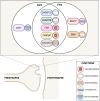Synaptopathy: presynaptic convergence in frontotemporal dementia and amyotrophic lateral sclerosis
- PMID: 38451707
- PMCID: PMC11224618
- DOI: 10.1093/brain/awae074
Synaptopathy: presynaptic convergence in frontotemporal dementia and amyotrophic lateral sclerosis
Abstract
Frontotemporal dementia and amyotrophic lateral sclerosis are common forms of neurodegenerative disease that share overlapping genetics and pathologies. Crucially, no significantly disease-modifying treatments are available for either disease. Identifying the earliest changes that initiate neuronal dysfunction is important for designing effective intervention therapeutics. The genes mutated in genetic forms of frontotemporal dementia and amyotrophic lateral sclerosis have diverse cellular functions, and multiple disease mechanisms have been proposed for both. Identification of a convergent disease mechanism in frontotemporal dementia and amyotrophic lateral sclerosis would focus research for a targetable pathway, which could potentially effectively treat all forms of frontotemporal dementia and amyotrophic lateral sclerosis (both familial and sporadic). Synaptopathies are diseases resulting from physiological dysfunction of synapses, and define the earliest stages in multiple neuronal diseases, with synapse loss a key feature in dementia. At the presynapse, the process of synaptic vesicle recruitment, fusion and recycling is necessary for activity-dependent neurotransmitter release. The unique distal location of the presynaptic terminal means the tight spatio-temporal control of presynaptic homeostasis is dependent on efficient local protein translation and degradation. Recently, numerous publications have shown that mutations associated with frontotemporal dementia and amyotrophic lateral sclerosis present with synaptopathy characterized by presynaptic dysfunction. This review will describe the complex local signalling and membrane trafficking events that occur at the presynapse to facilitate neurotransmission and will summarize recent publications linking frontotemporal dementia/amyotrophic lateral sclerosis genetic mutations to presynaptic function. This evidence indicates that presynaptic synaptopathy is an early and convergent event in frontotemporal dementia and amyotrophic lateral sclerosis and illustrates the need for further research in this area, to identify potential therapeutic targets with the ability to impact this convergent pathomechanism.
Keywords: amyotrophic lateral sclerosis; frontotemporal dementia; presynaptic; synaptic dysfunction; synaptic vesicle; synaptopathy.
© The Author(s) 2024. Published by Oxford University Press on behalf of the Guarantors of Brain.
Conflict of interest statement
The authors report no competing interests.
Figures



Similar articles
-
Biomarker discovery and development for frontotemporal dementia and amyotrophic lateral sclerosis.Brain. 2022 Jun 3;145(5):1598-1609. doi: 10.1093/brain/awac077. Brain. 2022. PMID: 35202463 Free PMC article. Review.
-
Impairments of inhibitory neurons in amyotrophic lateral sclerosis and frontotemporal dementia.Neurobiol Dis. 2024 Dec;203:106748. doi: 10.1016/j.nbd.2024.106748. Epub 2024 Nov 26. Neurobiol Dis. 2024. PMID: 39592063 Review.
-
A novel synaptopathy-defective synaptic vesicle protein trafficking in the mutant CHMP2B mouse model of frontotemporal dementia.J Neurochem. 2022 Feb;160(3):412-425. doi: 10.1111/jnc.15551. Epub 2021 Dec 11. J Neurochem. 2022. PMID: 34855215
-
Common Molecular Pathways in Amyotrophic Lateral Sclerosis and Frontotemporal Dementia.Trends Mol Med. 2016 Sep;22(9):769-783. doi: 10.1016/j.molmed.2016.07.005. Epub 2016 Aug 4. Trends Mol Med. 2016. PMID: 27498188 Review.
-
The clinical and pathological phenotype of C9ORF72 hexanucleotide repeat expansions.Brain. 2012 Mar;135(Pt 3):723-35. doi: 10.1093/brain/awr353. Epub 2012 Feb 1. Brain. 2012. PMID: 22300876
Cited by
-
Cognitive synaptopathy: synaptic and dendritic spine dysfunction in age-related cognitive disorders.Front Aging Neurosci. 2024 Oct 3;16:1476909. doi: 10.3389/fnagi.2024.1476909. eCollection 2024. Front Aging Neurosci. 2024. PMID: 39420927 Free PMC article. Review.
-
Molecular pathology, developmental changes and synaptic dysfunction in (pre-) symptomatic human C9ORF72-ALS/FTD cerebral organoids.Acta Neuropathol Commun. 2024 Sep 18;12(1):152. doi: 10.1186/s40478-024-01857-1. Acta Neuropathol Commun. 2024. PMID: 39289761 Free PMC article.
-
Apolipoproteins, lipids, lipid-lowering drugs and risk of amyotrophic lateral sclerosis and frontotemporal dementia: a meta-analysis and Mendelian randomisation study.J Neurol. 2024 Oct;271(10):6956-6969. doi: 10.1007/s00415-024-12665-x. Epub 2024 Sep 4. J Neurol. 2024. PMID: 39230722 Free PMC article.
-
Beginning from the end: the presynaptic terminal as a pathomechanism hub in frontotemporal dementia and amyotrophic lateral sclerosis.Neural Regen Res. 2025 Nov 1;20(11):3217-3218. doi: 10.4103/NRR.NRR-D-24-00639. Epub 2024 Oct 22. Neural Regen Res. 2025. PMID: 39715090 Free PMC article. No abstract available.
-
Synapse vulnerability and resilience across the clinical spectrum of dementias.Nat Rev Neurol. 2025 Jul;21(7):353-369. doi: 10.1038/s41582-025-01094-7. Epub 2025 May 22. Nat Rev Neurol. 2025. PMID: 40404832 Review.
References
-
- Ratnavalli E, Brayne C, Dawson K, Hodges JR. The prevalence of frontotemporal dementia. Neurology. 2002;58:1615–1621. - PubMed
-
- Woollacott IO, Rohrer JD. The clinical spectrum of sporadic and familial forms of frontotemporal dementia. J Neurochem. 2016;138 Suppl 1:6–31. - PubMed
-
- Hogan DB, Jetté N, Fiest KM, et al. . The prevalence and incidence of frontotemporal dementia: A systematic review. Can J Neurol Sci. 2016;43 Suppl 1:S96–S109. - PubMed
Publication types
MeSH terms
Grants and funding
LinkOut - more resources
Full Text Sources
Medical

